A Geoinformation-Based Approach for Mapping Coastal Vulnerability in Sweden
Abstract
1. Introduction
2. Experimental Setup
2.1. Study Area
2.2. CVI Variables
2.2.1. Geomorphology
2.2.2. Coastal Slope
2.2.3. Hydrodynamic Parameters
2.2.4. Shoreline Change
3. Methodology
3.1. Pre-Processing
3.2. CVI Calculation
4. Results
5. Discussion
6. Closing Remarks
Author Contributions
Funding
Data Availability Statement
Conflicts of Interest
References
- Short, A.D. Coastal Processes and Beaches. Nat. Educ. Knowl. 2012, 3, 15. [Google Scholar]
- Mörner, N.A.; Finkl, C.W. Coastal Erosion. In Encyclopedia of Coastal Science; Encyclopedia of Earth Sciences Series; Finkl, C.W., Makowski, C., Eds.; Springer: Cham, Switzerland, 2019. [Google Scholar] [CrossRef]
- Alessa, L.; Valentine, J.; Moon, S.; McComb, C.; Hicks, S.; Romanovsky, V.; Xiao, M.; Kliskey, A. Toward a Permafrost Vulnerability Index for Critical Infrastructure, Community Resilience and National Security. Geographies 2023, 3, 522–542. [Google Scholar] [CrossRef]
- Toumasi, P.; Petropoulos, G.P.; Detsikas, S.E.; Kalogeropoulos, K.; Tselos, N.G. Coastal Vulnerability Impact Assessment under Climate Change in the Arctic Coasts of Tromsø, Norway. Earth 2024, 5, 640–653. [Google Scholar] [CrossRef]
- Casas-Prat, M.; Wang, X.L. Projections of Extreme Ocean Waves in the Arctic and Potential Implications for Coastal Inundation and Erosion. J. Geophys. Res. Ocean. 2020, 125, e2019JC015745. [Google Scholar] [CrossRef]
- Nielsen, D.M.; Pieper, P.; Barkhordarian, A.; Overduin, P.; Ilyina, T.; Brovkin, V.; Dobrynin, M. Increase in Arctic Coastal Erosion and Its Sensitivity to Warming in the Twenty-First Century. Nat. Clim. Chang. 2022, 12, 263–270. [Google Scholar] [CrossRef]
- Tanguy, R.; Bartsch, A.; Nitze, I.; Irrgang, A.; Petzold, P.; Widhalm, B.; von Baeckmann, C.; Boike, J.; Martin, J.; Efimova, A.; et al. Pan-Arctic assessment of coastal settlements and infrastructure vulnerable to coastal erosion, sea-level rise, and permafrost thaw. Earth’s Future 2024, 12, e2024EF005013. [Google Scholar] [CrossRef]
- Whalen, D.; Forbes, D.L.; Kostylev, V.; Lim, M.; Fraser, P.; Nedimović, M.R.; Stuckey, S. Mechanisms, Volumetric Assessment, and Prognosis for Rapid Coastal Erosion of Tuktoyaktuk Island, an Important Natural Barrier for the Harbour and Community. Can. J. Earth Sci. 2022, 59, 945–960. [Google Scholar] [CrossRef]
- Ebert, K.; Ekstedt, K.; Jarsjö, J. GIS Analysis of Effects of Future Baltic Sea Level Rise on the Island of Gotland, Sweden. Nat. Hazards Earth Syst. Sci. 2016, 16, 1571–1582. [Google Scholar] [CrossRef]
- Swedish Ministry of the Environment. Sweden’s Adaptation Communication—A Report to the United Nations Framework Convention; Government Offices of Sweden: Stockholm, Sweden, 2022; Available online: https://unfccc.int/sites/default/files/ACR/2022-11/ADCOM_Sweden_November_221114.pdf (accessed on 1 October 2025).
- Leszczyńska, K.; Alexanderson, H.; Clemmensen, L.B.; Giza, A.; Lorenz, S.; Moskalewicz, D.; Oliński, P.; Paprotny, D.; Rosentau, A.; Rutgersson, A.; et al. A Review of Storms and Marine Coastal Flooding in the Baltic Sea—Insights from Instrumental, Historical and Sedimentary Record. Earth-Sci. Rev. 2025, 266, 105137. [Google Scholar] [CrossRef]
- Kopp, H.; Chiocci, F.L.; Berndt, C.; Çağatay, M.N.; Ferreira, T.; Fortes, C.J.E.M.; Gràcia, E.; González Vega, A.; Kopf, A.J.; Yeo, I.A. Marine Geohazards: Safeguarding Society and the Blue Economy; Position Paper 26 of the European Marine Board; European Marine Board: Ostend, Belgium, 2021; Volume 26, 100p. [Google Scholar] [CrossRef]
- Ren, Z.; Higuera, P.; Liu, P.L.-F. On Tsunami Waves Induced by Atmospheric Pressure Shock Waves after the 2022 Hunga Tonga-Hunga Ha’apai Volcano Eruption. J. Geophys. Res. Ocean. 2023, 128, e2022JC019166. [Google Scholar] [CrossRef]
- Wang, Y.; Zamora, N.; Quiroz, M.; Satake, K.; Cienfuegos, R. Tsunami Resonance Characterization in Japan due to Trans-Pacific Sources: Response on the Bay and Continental Shelf. J. Geophys. Res. Ocean. 2021, 126, e2020JC017037. [Google Scholar] [CrossRef]
- Xu, I.; Xu, C.; Ren, Z.; Wang, D. Numerical Investigation of Rip Currents near a Barred Beach Induced by Irregular Waves. Proc. Inst. Mech. Eng. Part M J. Eng. Marit. Environ. 2024, 239, 418–434. [Google Scholar] [CrossRef]
- Ji, X.; Wang, H.; Lu, X.; Wang, D.; Zou, L.; Ren, Z. Hydrodynamic Performance of Riprap Structures in Reef Lagoon under Extreme Wave Loading: Insights from Porous Media Simulations. Phys. Fluids 2025, 37, 051702. [Google Scholar] [CrossRef]
- Sugiyama, S.; Yamaguchi, A.; Watanabe, T.; Tojo, Y.; Hayashi, N.; Thiebot, J.-B.; Tomiyasu, M.; Hasegawa, K.; Mitani, Y.; Otsuki, M.; et al. Changes in the Coastal Environments and Their Impact on Society in the Qaanaaq Region, Northwestern Greenland. Polar Sci. 2025, 101206. [Google Scholar] [CrossRef]
- LIFE Coast Adapt. Protection of Coastal Values. 2024. Available online: https://utveckling.skane.se/siteassets/publikationer/life-coast-adapt-engelska.pdf (accessed on 25 May 2025).
- Donatus, B.; Angnuureng, B.; Charuka, B.; Almar, R.; Dada, O.A.; Asumadu, R. Challenges and Lessons Learned from Global Coastal Erosion Protection Strategies. iScience 2025, 28, 112055. [Google Scholar] [CrossRef]
- Fuldauer, L.I.; Adshead, D.; Thacker, S.; Gall, S.; Hall, J.W. Evaluating the Benefits of National Adaptation to Reduce Climate Risks and Contribute to the Sustainable Development Goals. Glob. Environ. Change 2022, 76, 102575. [Google Scholar] [CrossRef]
- Tsatsaris, A.; Kalogeropoulos, K.; Stathopoulos, N.; Louka, P.; Tsanakas, K.; Tsesmelis, D.E.; Krassanakis, V.; Petropoulos, G.P.; Pappas, V.; Chalkias, C. Geoinformation Technologies in Support of Environmental Hazards Monitoring under Climate Change: An Extensive Review. ISPRS Int. J. Geo-Inf. 2021, 10, 94. [Google Scholar] [CrossRef]
- Kim, J.-I.; Hyun, C.-U.; Han, H.; Kim, H.-C. Digital Surface Model Generation for Drifting Arctic Sea Ice with Low-Textured Surfaces Based on Drone Images. ISPRS J. Photogramm. Remote Sens. 2021, 172, 147–159. [Google Scholar] [CrossRef]
- Petropoulos, G.P.; Petsini, T.; Detsikas, S.E. Geoinformation Technology in Support of Arctic Coastal Properties Characterization: State of the Art, Challenges, and Future Outlook. Land 2024, 13, 776. [Google Scholar] [CrossRef]
- Azlan, A.; Sahat, S.; Daud, M.E.; Kaamin, M.; Sultan, Z. Assessing Coastal Erosion Risks: A Comparative Study of Coastal Vulnerability Index and Coastal Erosion Risk Assessment Methods. J. Adv. Res. Des. 2025, 132, 91–102. [Google Scholar] [CrossRef]
- Gornitz, V.; White, T.; Cushman, R. Vulnerability of the U.S. to Future Sea Level Rise; Oak Ridge National Laboratory: Oak Ridge, TN, USA, 1991. [Google Scholar]
- Thieler, E.R.; Hammar-Klose, E.S. National Assessment of Coastal Vulnerability to Future Sea-Level Rise: Preliminary Results for the U.S. Pacific Coast. In U.S. Geological Survey Open-File Report; U.S. Geological Survey: Woods Hole, MA, USA, 2000. Available online: http://pubs.usgs.gov/of/2000/of00-178/ (accessed on 1 October 2025).
- Pendleton, E.A.; Hammer-Klose, E.S.; Thieler, E.R.; Williams, S.J. Coastal Vulnerability Assessment of Gulf Islands National Seashore (GUIS) to Sea Level Rise; U.S. Geological Survey Open-File Report 03-108; U.S. Geological Survey: Woods Hole, MA, USA, 2004; 18p. Available online: http://pubs.usgs.gov/of/2003/of03-108/ (accessed on 1 October 2025).
- Noor, N.M.; Abdul Maulud, K.N. Coastal Vulnerability: A Brief Review on Integrated Assessment in Southeast Asia. J. Mar. Sci. Eng. 2022, 10, 595. [Google Scholar] [CrossRef]
- Rocha, C.; Antunes, C.; Catita, C. Coastal Indices to Assess Sea-Level Rise Impacts—A Brief Review of the Last Decade. Ocean Coast. Manag. 2023, 237, 106536. [Google Scholar] [CrossRef]
- Theocharidis, C.; Doukanari, M.; Kalogirou, E.; Christofi, D.; Mettas, C.; Kontoes, C.; Hadjimitsis, D.; Argyriou, A.V.; Eliades, M. Coastal Vulnerability Index (CVI) Assessment: Evaluating Risks Associated with Human-Made Activities along the Limassol Coastline, Cyprus. Remote Sens. 2024, 16, 3688. [Google Scholar] [CrossRef]
- Statistics Sweden (SCB). 2024. Available online: https://www.statistikdatabasen.scb.se/ (accessed on 1 October 2025).
- Łabuz, T.A. Environmental Impacts—Coastal Erosion and Coastline Changes. In Second Assessment of Climate Change for the Baltic Sea Basin; The BACC II Author Team, Ed.; Regional Climate Studies; Springer: Cham, Switzerland, 2015. [Google Scholar] [CrossRef]
- SGU Geology of Sweden. 2020. Available online: https://www.sgu.se/en/geology-of-sweden/ (accessed on 1 October 2025).
- Hieronymus, M.; Kalén, O. Sea-Level Rise Projections for Sweden Based on the New IPCC Special Report: The Ocean and Cryosphere in a Changing Climate. Ambio 2020, 49, 1587–1600. [Google Scholar] [CrossRef] [PubMed]
- SCB Islands in Sweden. Number, Area and Perimeter by Region. 2013. Available online: https://www.statistikdatabasen.scb.se/pxweb/en/ssd/START__MI__MI0812__MI0812T/OarArealOmk/ (accessed on 1 October 2025).
- Reusch, T.B.H.; Dierking, J.; Andersson, H.C.; Bonsdorff, E.; Carstensen, J.; Casini, M.; Zandersen, M. The Baltic Sea as a Time Machine for the Future Coastal Ocean. Sci. Adv. 2018, 4, eaar8195. [Google Scholar] [CrossRef]
- Komi, A.; Petropoulos, A.; Evelpidou, N.; Poulos, S.; Kapsimalis, V. Coastal Vulnerability Assessment for Future Sea Level Rise and a Comparative Study of Two Pocket Beaches in Seasonal Scale, Ios Island, Cyclades, Greece. J. Mar. Sci. Eng. 2022, 10, 1673. [Google Scholar] [CrossRef]
- Pantusa, D.; D’Alessandro, F.; Riefolo, L.; Principato, F.; Tomasicchio, G.R. Application of a Coastal Vulnerability Index. A Case Study along the Apulian Coastline, Italy. Water 2018, 10, 1218. [Google Scholar] [CrossRef]
- Xu, H.; Xu, N.; Zhang, C.; Chi, S.; Li, Y.; Li, W.; Lu, H. A Machine Learning Based Estimation Method of Beach Slopes at a National Scale: A Case Study of New Zealand. Geo-Spat. Inf. Sci. 2025, 1–20. [Google Scholar] [CrossRef]
- Manno, G.; Azzara, G.; Lo Re, C.; Martinello, C.; Basile, M.; Rotigliano, E.; Ciraolo, G. An Approach for the Validation of a Coastal Erosion Vulnerability Index: An Application in Sicily. J. Mar. Sci. Eng. 2023, 11, 23. [Google Scholar] [CrossRef]
- Intergovernmental Panel on Climate Change (IPCC). Climate Change 2021—The Physical Science Basis: Working Group I Contribution to the Sixth Assessment Report of the Intergovernmental Panel on Climate Change. 2021. Available online: https://www.ipcc.ch/report/ar6/wg1/ (accessed on 1 October 2025).
- SMA Future Sea Levels in Sweden. 2025. Thomas Hammarklint Published 2019-11-30. Available online: https://www.bshc.pro/wp-content/uploads/Future_sea_levels.pdf (accessed on 1 October 2025).
- Beluru, J.; Akshaya, H.; Hegde, A.V. GIS Based Approach for Vulnerability Assessment of the Karnataka Coast, India. Adv. Civ. Eng. 2016, 2016, 5642523. [Google Scholar] [CrossRef]
- SMHI. Ocean Waves 2016. 2024. Available online: https://www.smhi.se/klimat/klimatet-da-och-nu/arets-vatten/vattenaret/2017-03-31-havsvagor-2016?utm (accessed on 1 October 2025).
- Adell, A.; Nunes De Brito Junior, A.; Almström, B.; Goodfellow, B.; Bokhari Irminger, S.; Hallin, C.; Nyberg, J. Open-Access Portal with Hindcast Wave Data for Skåne and Halland. Vatten Tidskr. Vattenvård/J. Water Manag. Res. 2021, 77, 81–90. Available online: https://www.tidskriftenvatten.se/wp-content/uploads/2021/06/VATTEN_21_2_81-90.pdf (accessed on 1 October 2025).
- Sokolov, A.; Chubarenko, B. Baltic Sea Wave Climate in 1979–2018: Numerical Modelling Results. Ocean Eng. 2024, 320, 117088. [Google Scholar] [CrossRef]
- Luijendijk, A.; Hagenaars, G.; Ranasinghe, R.; Baart, F.; Donchyts, G.; Aarninkhof, S. The State of the World’s Beaches. Sci. Rep. 2018, 8, 6641. [Google Scholar] [CrossRef]
- Vousdoukas, M.I.; Ranasinghe, R.; Mentaschi, L.; Plomaritis, T.A.; Athanasiou, P.; Luijendijk, A.; Feyen, L. Sandy Coastlines under Threat of Erosion. Nat. Clim. Change 2020, 10, 260–263. [Google Scholar] [CrossRef]
- Różyński, G. Coastal Protection Challenges after Heavy Storms on the Polish Coast. Cont. Shelf Res. 2023, 266, 104997. [Google Scholar] [CrossRef]
- Glansholm, H. Coastal Erosion on Högklint, Gotland: Processes, Rate, and Future Implications. Master’s Thesis, Uppsala University, Department of Earth Sciences, Uppsala, Sweden, 2015. Available online: https://uu.diva-portal.org/smash/record.jsf?pid=diva2%3A856411&dswid=6354 (accessed on 1 October 2025).
- Þórisdóttir, V. Future Challenges of Kalmar City: Coastal Adaptation Strategies Design in Relation to Sea Level Rise. Master’s Thesis, Swedish University of Agricultural Sciences (SLU), Department of Urban and Rural Development, Uppsala, Sweden, 2023. Available online: http://urn.kb.se/resolve?urn=urn:nbn:se:slu:epsilon-s-500682 (accessed on 1 October 2025).
- SGU Kartvisaren: Erosionsförhållanden på Stranden. 2023. Available online: https://apps.sgu.se/kartvisare/kartvisare-skanestrand.html (accessed on 1 October 2025).
- Hamilton, A. Coastal Erosion in Ängelholm: A Case Study Tracking Recent and Historical Changes to Vejbystrand. Bachelor’s Thesis, Lund University, Lund, Sweden, 2019. [Google Scholar] [CrossRef]
- Engström, S.; Olsson, E. Coastal Response to Sea Level Rise in Ystad Municipality: Development, Comparison and Application of Bruun Rule-Based Methods. Master’s Thesis, Lund University, Division of Water Resources Engineering, Department of Building & Environmental Technology, Lund, Sweden, 2021. Available online: https://lup.lub.lu.se/luur/download?func=downloadFile&recordOId=9060526&fileOId=9060529 (accessed on 1 October 2025).
- Shugar, D.H.; Walker, I.J.; Lian, O.B.; Eamer, J.B.R.; Neudorf, C.; McLaren, D.; Fedje, D. Post-Glacial Sea-Level Change along the Pacific Coast of North America. Quat. Sci. Rev. 2014, 97, 170–192. [Google Scholar] [CrossRef]
- Greenberg, D.A.; Blanchard, W.; Smith, B.; Barrow, E. Climate Change, Mean Sea Level and High Tides in the Bay of Fundy. Atmos.-Ocean. 2012, 50, 261–276. [Google Scholar] [CrossRef]
- Tosi, L.; Da Lio, C.; Cosma, M.; Donnici, S. Vulnerability of Tidal Morphologies to Relative Sea-Level Rise in the Venice Lagoon. Sci. Total Environ. 2024, 905, 173006. [Google Scholar] [CrossRef]
- Gleizon, P.; Woolf, D. Wave Energy Assessment in Scottish Seas. In Proceedings of the 10th European Wave and Tidal Energy Conference (EWTEC), Aalborg, Denmark, 2–5 September 2013; Available online: https://www.researchgate.net/publication/263279982_Wave_Energy_Assessment_in_Scottish_Seas (accessed on 1 October 2025).
- Björkqvist, J.-V.; Tuomi, L.; Fortelius, C.; Pettersson, H.; Tikka, K.; Kahma, K.K. Improved Estimates of Nearshore Wave Conditions in the Gulf of Finland. J. Mar. Syst. 2017, 171, 43–53. [Google Scholar] [CrossRef]
- Sekovski, I.; Del Río, L.; Armaroli, C. Development of a Coastal Vulnerability Index Using Analytical Hierarchy Process and Application to Ravenna Province (Italy). Ocean Coast. Manag. 2020, 183, 104982. [Google Scholar] [CrossRef]
- Barzehkar, M.K.; Parnell, K.; Soomere, T. Extending Multi-Criteria Coastal Vulnerability Assessment to Low-Lying Inland Areas: Examples from Estonia, Eastern Baltic Sea. Estuar. Coast. Shelf Sci. 2024, 311, 109014. [Google Scholar] [CrossRef]
- Tita, E.P.; Petropoulos, G.P.; Varvatsouli, D. Exploring the Relationships between Coastal Vulnerability and Socio-Economic Variables in the Context of Climate Change Using Geoinformatics for the Region of Longyearbyen, Svalbard. Remote Sens. Appl. Soc. Environ. 2025, 30, 101642. [Google Scholar] [CrossRef]
- Boumpoulis, V.D.; Depountis, N.; Dimas, A.; Grivas, E.; Karymbalis, E. Presentation and Analysis of the Geotechnical Coastal Vulnerability Index and Validation of Its Application to Coastal Erosion Problems. Sci. Rep. 2025, 15, 1424. [Google Scholar] [CrossRef] [PubMed]
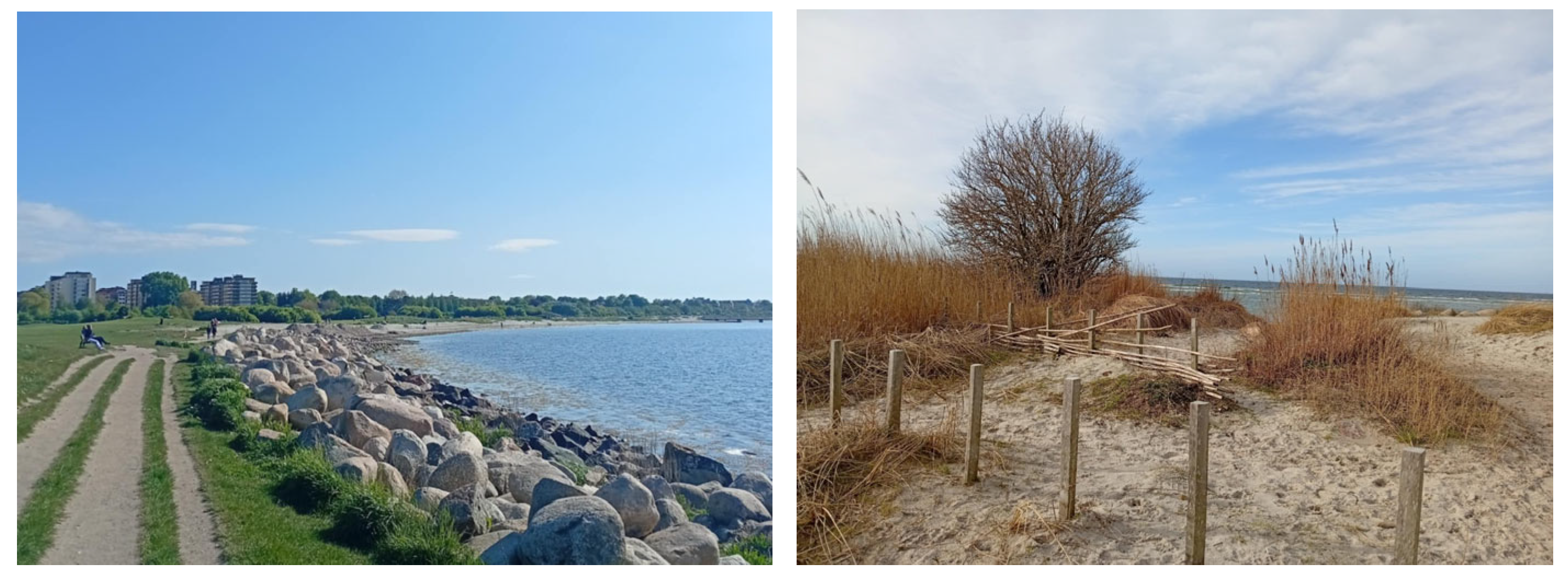
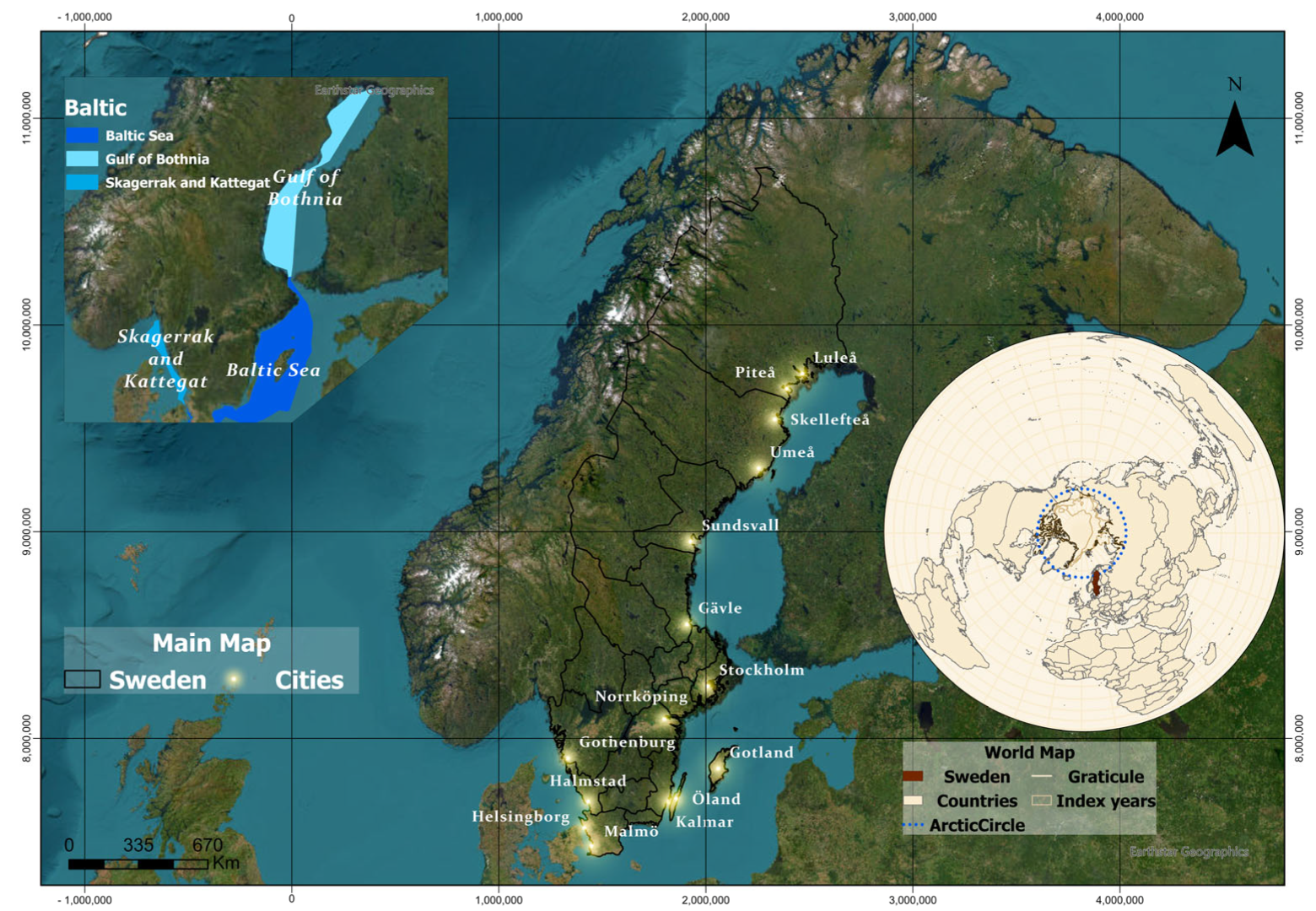
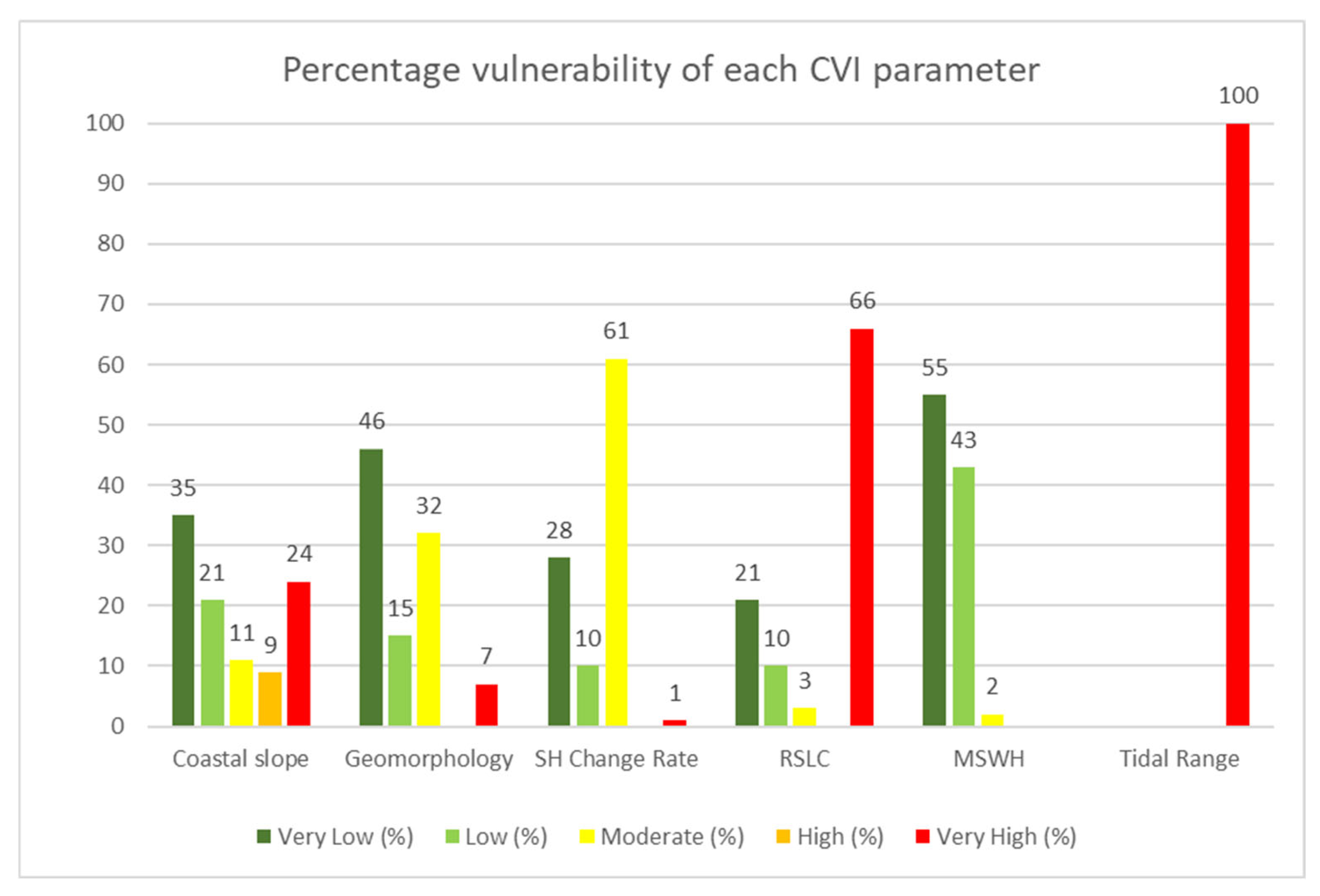
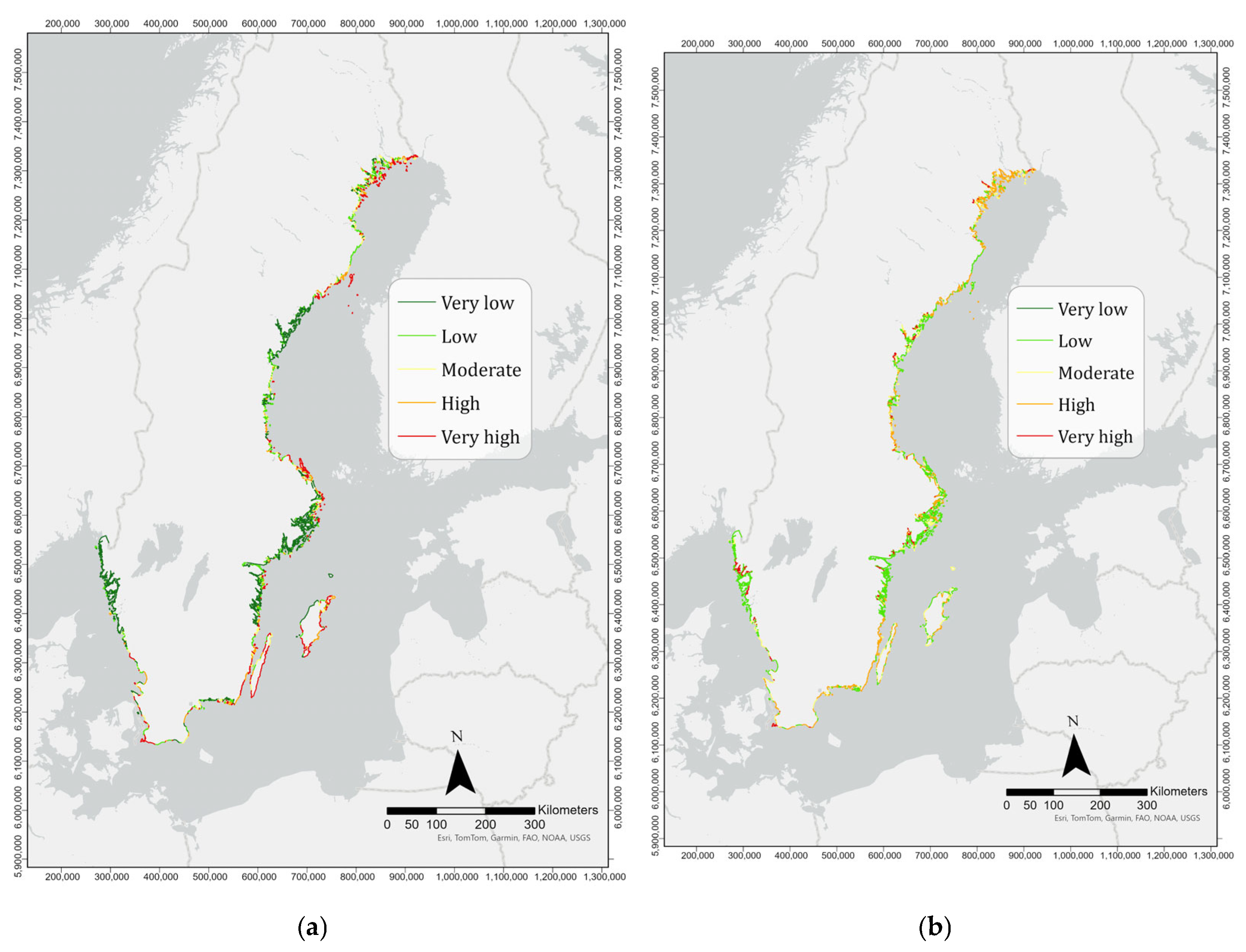
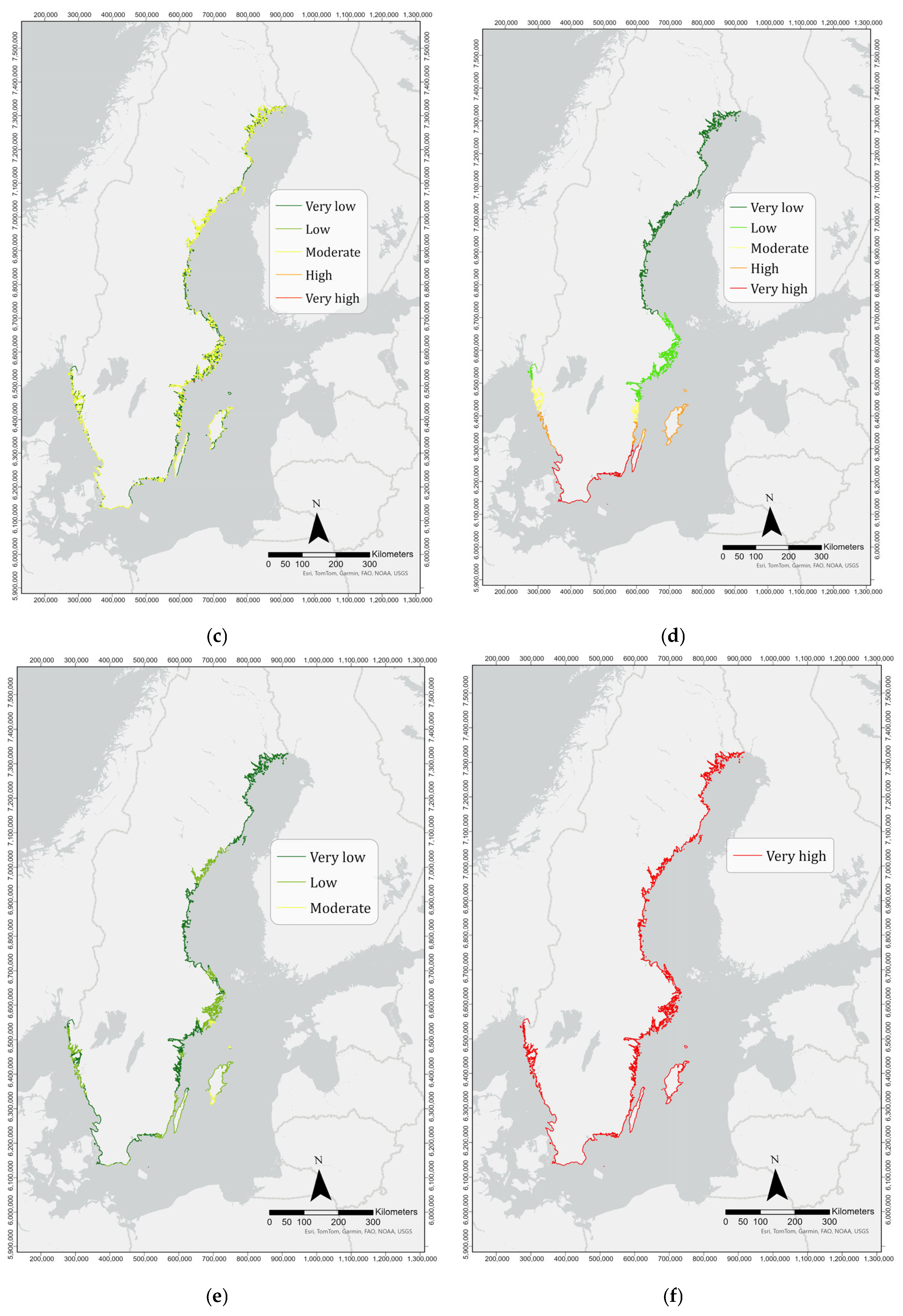
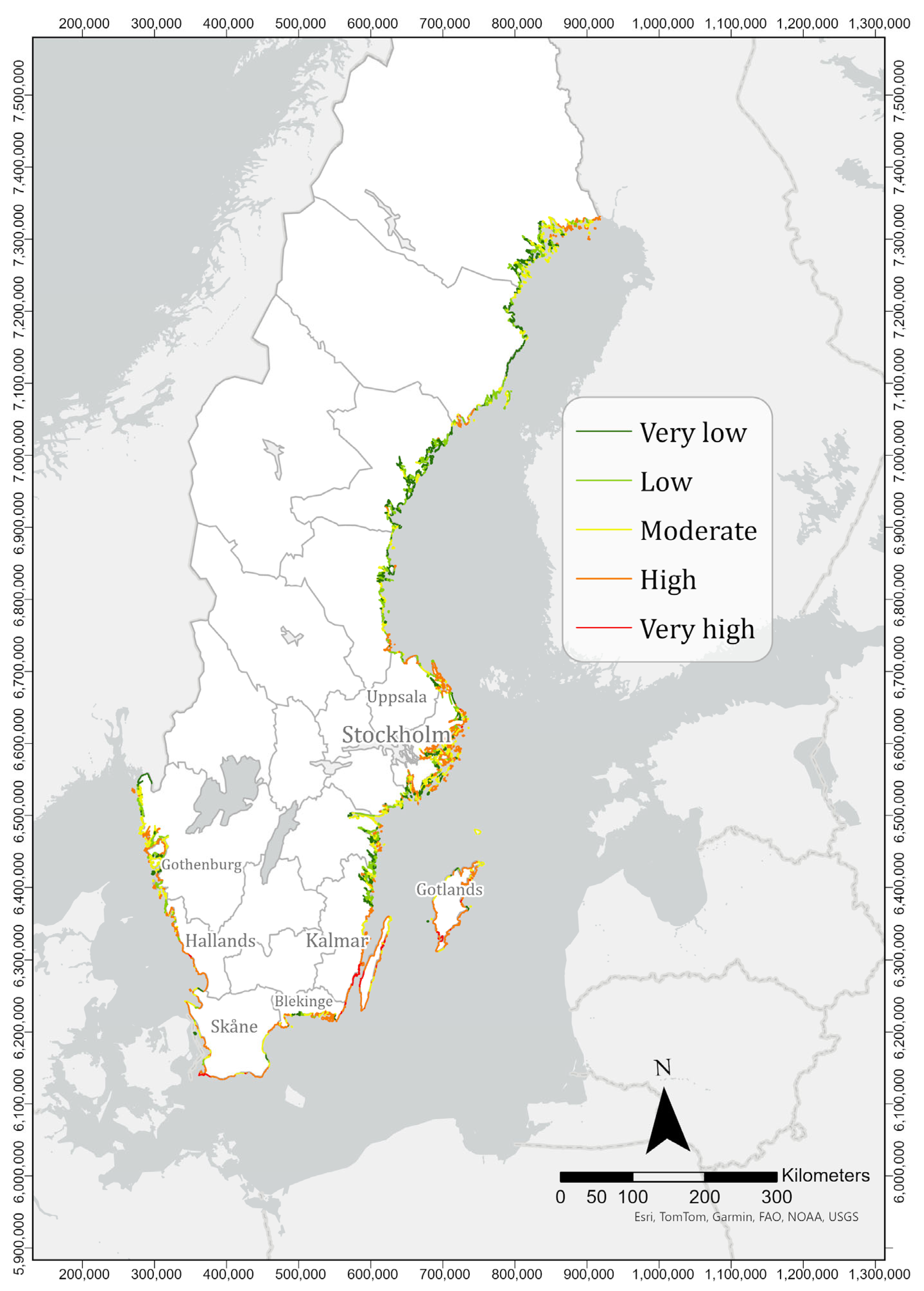
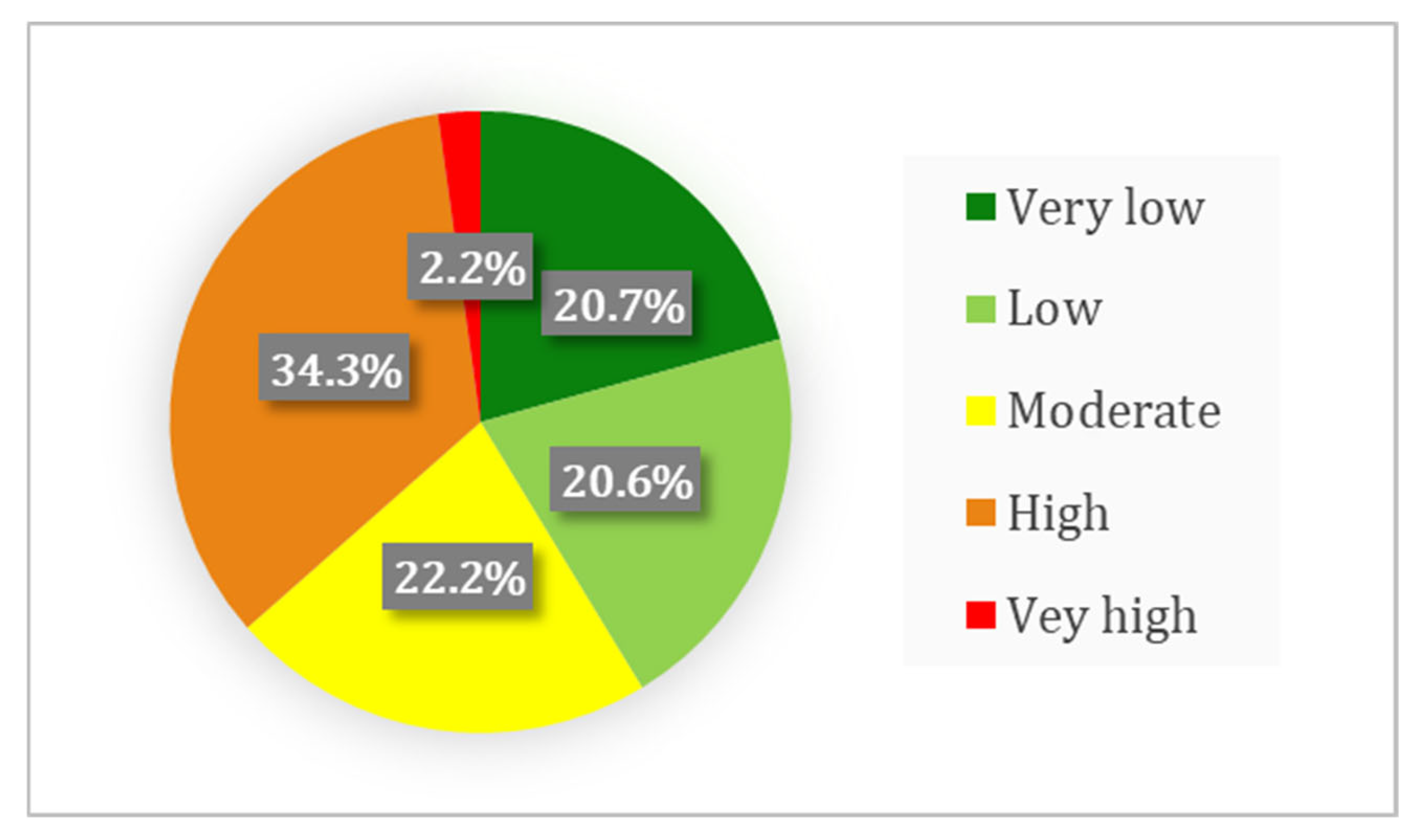
| Variable | Source | Reference Period | Resolution/Accuracy | Format |
|---|---|---|---|---|
| Geomorphology | EMODnet Geology/coastal type https://emodnet.ec.europa.eu/geoviewer/#!/ (accessed on 25 May 2025) | - | ~1:250,000 scale (vector shoreline classification) | Shapefile/WebGIS |
| Coastal Slope | https://portal.opentopography.org/arcticDem?opentopoID=OTSDEM.112018.3413.3 (accessed on 25 May 2025) | - | ~32 m horizontal resolution | Raster (GeoTIFF) |
| Mean wave height (m) | Wave model data (SGI, LTH, SGU) https://gis.sgi.se/kustdataportal/# (accessed on 25 May 2025) | 1979–2018 | 3-hourly temporal resolution; ~3–5 km spatial resolution | Model output (Time series (CSV)) |
| Relative Sea-level change (mm/y) | SMA 2025 https://www.bshc.pro/wp-content/uploads/Future_sea_levels.pdf (Accessed on 25 May 2025) | IPCC 2100 | Tide gauge network (86 stations); vertical datum RH2000 | Report (PDF), Tables |
| Shoreline erosion/accretion (m/y) | EMODnet Geology/coastal migration https://emodnet.ec.europa.eu/geoviewer/#!/ (accessed on 25 May 2025) | - | ~1:250,000 scale, regional compilations | Shapefile/WebGIS |
| Tidal range (m) | Swedish Meteorological and Hydrological Institute (SMHI) https://www.smhi.se/vader/vader-till-havs/vattenstand-och-vagor (accessed on 25 May 2025) | - | - | - |
| Vulnerability | Very Low | Low | Moderate | High | Very High |
|---|---|---|---|---|---|
| Variables | 1 | 2 | 3 | 4 | 5 |
| Coastal slope (%) | >20 | 7.0–20 | 4.0–7.0 | 2.5–4 | <2.5 |
| Geomorphology | Rocky, cliffed coasts, Fjords, Fiards, Artif. Constructions | Medium Cliffs, Indented coasts | Low cliffs, Glacial drift, Alluvial plains, Beachrocks, Dunes, Mixed material | Cobble beaches, Estuaries, Lagoons | Barrier beaches, Sand beaches, Salt marshes, Mud flats, Deltas, Mangrove, Coral reefs |
| Shoreline erosion/accretion (m/yr) | >2.0 | 1.0–2.0 | −1.0–+1.0 | −1.0–−2.0 | <−2.0 |
| Relative sea-level change (mm/yr) | <1.8 | 1.8–2.5 | 2.5–3.0 | 3.0–3.2 | >3.2 |
| Mean Wave Height (m) | <0.55 | 0.55–0.85 | 0.85–1.05 | 1.05–1.25 | >1.25 |
| Mean Tide range(m) | >6.0 | 4.1–6.0 | 2.0–4.0 | 1.0–1.9 | <1.0 |
Disclaimer/Publisher’s Note: The statements, opinions and data contained in all publications are solely those of the individual author(s) and contributor(s) and not of MDPI and/or the editor(s). MDPI and/or the editor(s) disclaim responsibility for any injury to people or property resulting from any ideas, methods, instructions or products referred to in the content. |
© 2025 by the authors. Licensee MDPI, Basel, Switzerland. This article is an open access article distributed under the terms and conditions of the Creative Commons Attribution (CC BY) license (https://creativecommons.org/licenses/by/4.0/).
Share and Cite
Achmakidou, E.; Petropoulos, G.P.; Karkani, A.; Evelpidou, N.; Detsikas, S.E.; Tselos, G.N. A Geoinformation-Based Approach for Mapping Coastal Vulnerability in Sweden. Water 2025, 17, 3027. https://doi.org/10.3390/w17203027
Achmakidou E, Petropoulos GP, Karkani A, Evelpidou N, Detsikas SE, Tselos GN. A Geoinformation-Based Approach for Mapping Coastal Vulnerability in Sweden. Water. 2025; 17(20):3027. https://doi.org/10.3390/w17203027
Chicago/Turabian StyleAchmakidou, Eleni, George P. Petropoulos, Anna Karkani, Niki Evelpidou, Spyridon E. Detsikas, and Georgios Nektarios Tselos. 2025. "A Geoinformation-Based Approach for Mapping Coastal Vulnerability in Sweden" Water 17, no. 20: 3027. https://doi.org/10.3390/w17203027
APA StyleAchmakidou, E., Petropoulos, G. P., Karkani, A., Evelpidou, N., Detsikas, S. E., & Tselos, G. N. (2025). A Geoinformation-Based Approach for Mapping Coastal Vulnerability in Sweden. Water, 17(20), 3027. https://doi.org/10.3390/w17203027









